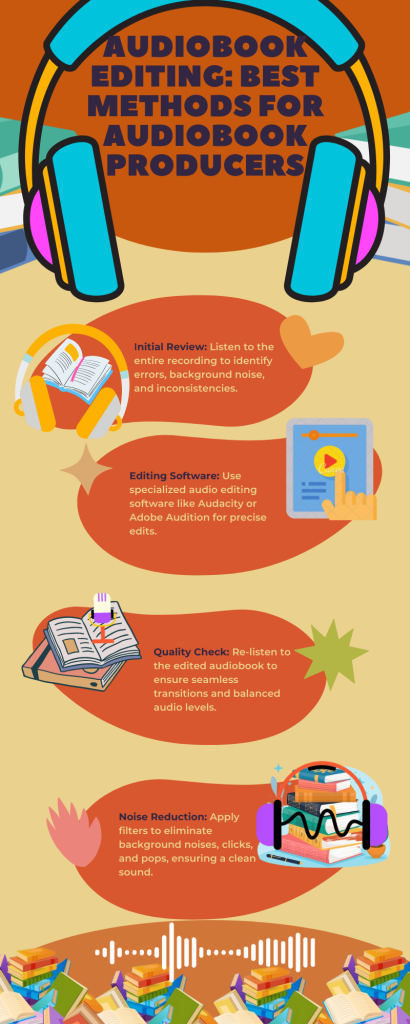Audiobook
Press The Play Button On The Audio To Listen Complete Article!
World of digital media, which is always changing, audiobooks have become a popular and easy way for people to learn and enjoy reading. As an audiobook producer, giving your viewers a smooth listening experience is important. This content piece will discuss the ten best ways to Audiobook Editing to make high-quality productions that keep your listeners interested from beginning to end.
1. Selecting the Right Recording Space:
Creating a perfect audiobook starts with a very important step: picking the right place to record. You can’t say enough about how important this first choice is since the recording environment greatly impacts the quality of the end product. A good recording place sets the stage for a smooth and efficient production process, which saves time and money in post-production.
One of the most important things to consider in an Audiobook Editing recording area is how well it treats sound. This means making the room so that sound doesn’t bounce around too much and doesn’t echo. Acoustic treatment can use special materials like acoustic panels, bass traps, and diffusers to make a setting that absorbs or spreads sound waves well.
2. Invest in Quality Equipment:
Buying good Audiobook Editing recording tools is one of the best investments you can make if you want to start making professional-quality audiobooks. The tools and equipment you choose will play a big role in capturing the narrator’s voice with the most clarity, depth, and sincerity, giving your listeners an engaging and immersive experience.
A good, reliable microphone is the most important part of any setup for recording a podcast. The microphone connects the narrator’s voice to the digital world by turning analog sound waves into digital audio files. It is important to choose a microphone that works well with the narrator’s voice and suits their style. Condenser mics are often used to record audiobooks because they are sensitive and can capture the narrator’s voice in all its subtleties.
3. Master the Art of Pacing:
Mastering the art of pacing is an important skill in audiobook editing that can make or break the listening experience for your audience. Pacing is how the story flows, directly affecting how emotionally involved and interested the viewer is. The key to making an audiobook publisher that keeps people interested from beginning to end is to find the right mix between a steady pace and natural pauses.
Pacing is one of the best ways to keep people interested without making them feel rushed. When the story is told too quickly, it can be hard for the audience to keep up and enjoy what is being said. On the other hand, if things move too slowly, people might get bored or lose interest. So, finding the sweet spot that keeps a nice rhythm going through the audiobook is important.
4. Removing Background Noise
Unwanted background noise is one of the most difficult things audiobook producers have to deal with. Unwanted sounds like hums, clicks, hisses, and background noises can distract listeners. They can also lower the general quality of the sound. Luckily, with the help of advanced noise audiobook editing tools and techniques, audio editors can effectively eliminate these problems during post-production. This ensures that the end product is clean, polished, and interesting to the audience.
The vital step in removing background noise is to find and analyze the parts of the sound causing trouble. Noise comes in many forms, such as electrical hums caused by faulty recording equipment, mouth clicks, and background talk that gets accidentally picked up during recording sessions. By carefully reviewing the audio tracks, editors can find these noise elements and devise a plan to eliminate them.
5. Edit for Clarity and Consistency
One of the main goals of an audiobook writer is to make the audio sound clearer and more consistent. During this careful editing phase, different things that might get in the way of the hearing experience are fixed. Audio editors can make a polished and professional end product that grabs the audience’s attention by fixing mispronounced words, reducing mouth noises, and fixing problems with the pace.
Mispronunciations are one of the most common problems when making a podcast. Even if a storyteller tries hard to say words correctly, it’s normal for them to make mistakes now and then. It’s important to listen carefully and catch any wrong words during rewriting. Then, audio editors can work with the narrator to re-record the parts with mistakes, ensuring that the right pronunciations fit in with the rest of the audiobook.
6. Embrace the Power of Sound Effects
Sound effects can add depth, emotion, and immersion to the narration when used thoughtfully and strategically. Publishing an audiobook is a journey that the listener will never forget. But it’s important to use sound effects sparingly and carefully because too many of them can make it hard to hear what’s being said and ruin the overall hearing experience.
Sound effects are strong tools that make stories more interesting. When used wisely, they can produce a multisensory experience beyond just words on a page. For example, subtle background sounds or ambiance can take the viewer to a specific place- a busy city street, a quiet forest, or a roaring ocean. These sounds can create a vivid and immersive background for the narration, making the setting and mood of the story appear more real to the audience.
7. Employ Proper EQ and Compression
Proper equalization (EQ) and compression techniques are crucial when editing audiobooks. Equalization is a fundamental tool for harmonizing the diverse sound frequencies within the recording, permitting each element to find its rightful place in the auditory spectrum. Meanwhile, compression ensures consistent volume levels, guaranteeing listeners an uninterrupted and uniform auditory journey. By delicately applying EQ adjustments and skillfully implementing compression settings, editors can sculpt a sonic landscape that captivates and engages audiences while maintaining the intended emotional resonance of the spoken words. The seamless interplay of EQ and compression transforms audiobook editing into an artful symphony of clarity and coherence.
8. Chapter Markers and Metadata
Chapter markers serve as navigational signposts within an audiobook, allowing listeners to easily jump to specific sections or chapters. These markers break down the audiobook into manageable segments, mimicking the experience of flipping through pages in a physical book or navigating chapters in a video. They enable listeners to skip to the most interesting or relevant sections, re-listen to favorite parts, or resume listening exactly where they left off. This feature greatly enhances the user experience by providing flexibility and control over their engagement with the content.
Consider a long audiobook that covers various topics or themes. Finding a particular passage or revisiting a section becomes time-consuming without chapter markers. However, with well-organized chapter markers, users can swiftly navigate to specific content, fostering a more interactive and engaging listening experience.
9. Quality Assurance and Proofing
The Quality Assurance and Proofing stage is an important step in the long process of making recordings. This important step happens before the recording is finished, and it takes several careful steps to ensure the final result is the best it can be.
During this step, a dedicated team is in charge of ensuring the recording meets strict quality standards. This team comprises skilled people with a good ear for details and a strong grasp of the standards set for the project.
The process starts with a thorough session of proof-listening. During this session, the recording is carefully played back to look for any mistakes or oddities that may have crept into the sound. These could include a wide range of problems, such as background noise, speech that is hard to understand, uneven level, or even technical problems.
10. Perform a Comprehensive Review
After the Audiobook editing process, it is important to do a complete review. Listen to the whole recording, from the beginning to the end. This step ensures that everything meets your quality standards and your viewers’ needs. Immersing yourself in the content from start to finish helps you catch any mistakes you might have missed, improve transitions, and ensure the finished product will work well for your target listeners. This careful review ensures your recording is clean and ready to make a good impression.

Conclusion
Audiobook editing is a fragile art that requires accuracy, creativity, and a deep understanding of the audience’s needs. Audiobook producers can take their work to new heights by choosing the right place to record, buying good tools, mastering the pace, getting rid of background noise, and ensuring the audio is clear and consistent. When you use sound effects, use the right EQ and compression, and add chapter markers and metadata, you can make the hearing experience more interesting and memorable. Producers can make sure their eBooks stand out in a crowded market by checking the quality, proofing them, and giving them a final, thorough review.




